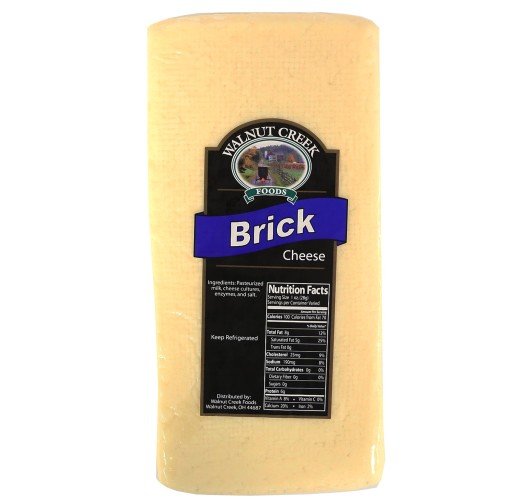Brick Cheese
Brick cheese is a type of American cheese that originated in the state of Wisconsin. It is named for its shape, which was traditionally rectangular like a brick, though it is now often sold in various forms, including blocks and wedges. Brick cheese is known for its mild flavor and smooth, creamy texture, making it a popular choice for a variety of culinary applications.
Here are some key characteristics and uses of brick cheese:
Texture: Brick cheese typically has a semi-soft to semi-firm texture. It is not as hard as aged cheeses like cheddar but is firmer than many other soft cheeses.
Flavor: It has a mild and buttery flavor with a slightly tangy or nutty undertone. The flavor can vary depending on the age of the cheese, with younger brick cheese being milder and creamier.
Color: The color of brick cheese ranges from pale yellow to orange, depending on factors like the cow's diet and any added colorants.
Melting Properties: Brick cheese melts well, which makes it a popular choice for use in grilled cheese sandwiches, burgers, and pizzas. It becomes gooey and creamy when melted.
Popular Uses: Brick cheese is often used in a variety of dishes, including sandwiches, quesadillas, casseroles, and macaroni and cheese. It can also be enjoyed on its own as a snack or appetizer.
Brick cheese is a type of American cheese that originated in the state of Wisconsin. It is named for its shape, which was traditionally rectangular like a brick, though it is now often sold in various forms, including blocks and wedges. Brick cheese is known for its mild flavor and smooth, creamy texture, making it a popular choice for a variety of culinary applications.
Here are some key characteristics and uses of brick cheese:
Texture: Brick cheese typically has a semi-soft to semi-firm texture. It is not as hard as aged cheeses like cheddar but is firmer than many other soft cheeses.
Flavor: It has a mild and buttery flavor with a slightly tangy or nutty undertone. The flavor can vary depending on the age of the cheese, with younger brick cheese being milder and creamier.
Color: The color of brick cheese ranges from pale yellow to orange, depending on factors like the cow's diet and any added colorants.
Melting Properties: Brick cheese melts well, which makes it a popular choice for use in grilled cheese sandwiches, burgers, and pizzas. It becomes gooey and creamy when melted.
Popular Uses: Brick cheese is often used in a variety of dishes, including sandwiches, quesadillas, casseroles, and macaroni and cheese. It can also be enjoyed on its own as a snack or appetizer.
Brick cheese is a type of American cheese that originated in the state of Wisconsin. It is named for its shape, which was traditionally rectangular like a brick, though it is now often sold in various forms, including blocks and wedges. Brick cheese is known for its mild flavor and smooth, creamy texture, making it a popular choice for a variety of culinary applications.
Here are some key characteristics and uses of brick cheese:
Texture: Brick cheese typically has a semi-soft to semi-firm texture. It is not as hard as aged cheeses like cheddar but is firmer than many other soft cheeses.
Flavor: It has a mild and buttery flavor with a slightly tangy or nutty undertone. The flavor can vary depending on the age of the cheese, with younger brick cheese being milder and creamier.
Color: The color of brick cheese ranges from pale yellow to orange, depending on factors like the cow's diet and any added colorants.
Melting Properties: Brick cheese melts well, which makes it a popular choice for use in grilled cheese sandwiches, burgers, and pizzas. It becomes gooey and creamy when melted.
Popular Uses: Brick cheese is often used in a variety of dishes, including sandwiches, quesadillas, casseroles, and macaroni and cheese. It can also be enjoyed on its own as a snack or appetizer.
Price is per pound. Order the number of pounds you would like.
Final price is determined by weight.

